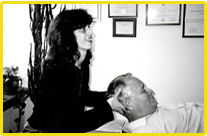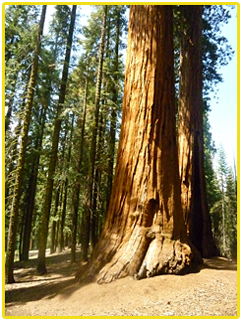
Massage is a hands-on treatment employed by a trained practitioner to relax muscles, and to stimulate blood and lymph flow. For the patient, this is mostly a passive method.
There are a wide variety of massages. Some approaches combine massage with bodywork. This is not intending to be a comprehensive list.

This is the oldest of the European forms of massage, and is known to have been in use since 3000 B.C. The classic "back rub" is an abbreviated form of therapeutic massage. Swedish massage was most often used in health spas and many nurses employ this type of massage as therapy in a medical setting. The massage usually is carried out with oils or lotions on bare skin. The person receiving the massage undresses, lies on a padded table, and normally is covered with a sheet.
Each therapist develops his or her own style based on the five basic strokes developed by Ling and Mezger:
Each of the basic strokes can be done with varying degrees of pressure. Generally, the therapist will ask or sense what works best for you, but don't be reluctant to express your preferences. Sessions are usually one hour.
Immediate benefits include muscle relaxation, stress reduction, and a feeling of well being. Studies show that therapeutic massage enhances the immune system and alleviates symptoms of depression.
Return to top of pageThese massage techniques are based on ancient Chinese medicine, which is based on the belief that good health depends on the circulation of chi, or vital life energy, along pathways in the body called meridians. Stimulation of certain points on the meridians releases blockages and opens the free flow of energy.
Acupressure therapists use the same 365 points that are used in acupuncture. They apply hand pressure to specific acupunture points. Shiatsu therapists make use of more than 600 points along the body's meridians, and may apply considerably more pressure, often with their elbows, knees, and feet. They also use assisted stretching of parts of the body to stimulate the circulation of chi.
The recipient, dressed in loose clothing, lies on a padded mat on the floor or massage table. Sessions may last 30 minutes to more than one hour.
Massage by acupressure and shiatsu produces relaxation and reduces stress. It can improve general health, and relieve pain. It also is used to relieve specific symptoms, such as sinus congestion and menstrual irregularities.
Return to top of pageAccording to Reflexology, every part of the body is connected to nerves on the feet, hands, ears, and skin. Because the feet have a high concentration of nerve endings, most Reflexologists perform their work on them. Lotions or oil may be used. To improve the functioning of specific organs or other parts of the body, their corresponding points on the feet are stimulated by finger pressure and stroking. Sessions last from 30 to 60 minutes.
Reflexology is used to treat stress disorders, pain, and imbalances such as indigestion.
Return to top of pagePediatric massage addresses the needs of infants and children. It may be especially beneficial for infants with colic or other physical discomfort.
Pregnancy massage can ease discomfort and relax muscles. An orthopedic support on the massage table allows a woman to have a facedown massage even when she is at full term.
For either pediatric or pregnancy massage, take the time to find a well-qualified practitioner.
Return to top of pageThis form of therapeutic massage addresses sports injuries and muscle tension. It also may be given before sports activity to optimize performance, or after to prevent cramping and reduce tension.
Sports massage usually is applied more vigorously than a Swedish-type massage. Specific massages have been developed for different types of sports. Some people seek out therapists who have specialized in treating participants in their sport.
Medical massage may be prescribed by a physician or chiropractor for specific sports injuries that make certain kinds of movement difficult or painful.
Return to top of pageTrigger-point therapy focuses on specific complaints, such as neck stiffness, back pain, frozen shoulder, or muscles spasms. Trigger points occur in muscles, tendons, and the connective tissue (fascia) around nerves, muscles, and bones. Trigger points often radiate pain to other parts of the body.
The therapist applies deep, continuous pressure to the irritated point. The area is first prepared with massage before deep pressure is applied with hand or elbow. After the tension in the point has been released, the muscles around it are stretched and stroked. A session lasts about one hour.
Trigger-point therapy is frequently used by physicians, chiropractors, and physical therapists on patients who are recovering from surgery, injuries, and automobile accidents.
Return to top of pageThis deep massage/bodywork is directed at the body's connective tissue (fascia), which surrounds the nerves, muscles, and bones. Structural Integration may cause discomfort and pain as the Structural Integration practitioner uses hands, elbows, and arms to press and stretch adhesions in the connective tissue. The goal is to restore flexibility and alignment.
Structural Integration is a very systematic approach whereas practitioners start working on the outer layers, then work deeper and deeper until the core layers are penetrated. They manipulate connective tissue by lengthening and breaking up adhesions to allow the body to be most efficient when lined up to its vertical (gravity) axis, called the Structural Integration line.
Structural Integration is given in a series of 10 sessions, each directed at a different portion of the body. In addition to massage, the patient/player is taught how to move more freely.
Benefits of Structural Integration include greater freedom of movement, increased circulation and energy, relief from chronic pain, and may also speed recovery from injury.
Return to top of pageMyofacial release is an osteopathic term coined by Dr. Robert Ward John, Barnes, a physical therapist developed a system that evaluates the fascia by using osteopathic methods, craniosacral therapy, Structural Integration, and physical therapy.
Myofascial release is a gentle approach that identifies and releases constricted areas in the connective tissue surrounding nerves, muscles, and bones. The belief is that the connective tissue becomes constricted due to illness, stress, or injury.
Treatment consists of strokes and stretching called unwinding, which helps the practitioner find specific areas of trauma called still points. Sessions can be from 30 to 90 minutes. Myofascial therapists also teach the patient stretching exercises to help them maintain their health.
Myofascial release relieves pain associated with muscle tightness, headaches, fibromyalgia, and scoliosis, and can help recovery from injury.
Myofascial therapy provides relief for chronic neck and back pain, and aids in the recovery of spinal cord injuries. It also is effective for traumatic stress syndrome and some disorders of the nervous system.
Return to top of pageThis is a combination of massage and bodywork that releases chronic physical tension by realigning the body, first, with deep massage, followed by movement re-education, and learning by guided dialog how our emotions specifically affect the body.
Joseph Heller, with a background in aerospace engineering, emphasizes structural alignment and integration. There are a series of 11 sessions that combine physical and psychological aspects.
Sessions focus on different parts of the body and its corresponding movements, such as breathing, standing, holding. The initial sessions deal with the stages of development in early childhood. In addition to movement, simple suggestion, visualization, and video feedback may be used to enhance the awareness of the link between emotions and the state of the body.
Sessions last 90 minutes.
The goal is to realign the body to gain a sense of well-being. Effective for relief from chronic pain and sports injuries.
Return to top of pageThe role of lymph fluids is to remove waste products from tissues, and transport them to the bloodstream to be eliminated. Nodes are located all over the body (many in the neck region) and they often accumulate fluids,which is called edema (swelling of tissues). Lymphatic massage does not work on muscle.
Manual lymph drainage is very light technique. Pressure can be light or deep. A pumping action is used. Dr. Vodder, the originator of this type of massage, has clinics in Europe.
Lymphatic massage has been benificial for post-surgical procedures, such as mastectomy, hysterectomy, etc., and for chronic conditions such as sinusitis, arthritis, and emphysema.
Return to top of pageDeveloped in Germany, Beindegewebsmassage is also known as connective tissue massage or reflexive therapy of the connective tissue.
The practitioner strokes the layers just below the skin.to impact the fascia layer, which has many sensory nerve endings. This sets up a reflex from the skin to the organs -- not unlike acupuncture. No lotions are used, and the series of strokes are called hooking, smoothing, etc.
The client may experience a scratching, or cutting, sensation as if sharp lines were etched on the skin, but pain is not experienced. Most treatments are given from a seated postion that usually begins at the sacrum (triangular bone at bottom of spine) to induce relaxation by activating the parasympathetic portion of the autonomic nervous system.
Return to top of pageTuina is a oriental massage/bodywork that was developed in China over 2000 years ago. It uses a traditional, meridian-based, medical theory based on the flow of chi (vital life force). It is a more rigorous alternative to Swedish massage.
Tuina combines massage to the soft tissues, acupressure, and manipulation of the musculo-skeletal system. Linament, compresses, or chinese herbs are used to enhance this approach.
Tuina is used for specific musculo-skeletal disorders and stress related disorders that effect the digestive, reproductive and respiratory systems.
Return to top of pageThai massage is a blend of Chinese medicine and Ayurveda (ayus=life, veda=sacred knowledge), traditional Hindu medicine that seeks to balance bodily systems by using diet, herbs, and yoga.
Gentle rocking motions and stretching of the body, as well as stimulation of specific acupuncture points, are used by Thai massage practitioners.
Return to top of pageThis massage is a combination of classical Swedish massage with Charlotte Selver's personal style, which used environmental elements unique to the experimental Esalen community. This technique began in the early 1960s.
Return to top of pageA combination of Swedish-type massage and aroma therapy, which makes use of oils containing plant and flower aromas, such as peppermint, sage, and lavender, to treat specific problems.
Return to top of pageThis technique combines yoga breathing exercises, Swedish-type massage, and energy balancing techniques.
Return to top of page